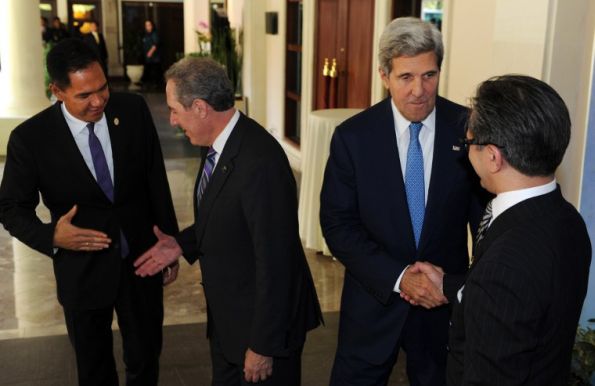10-06-2013 12:21 AM
Asia-Pacific Economic Co-operation: APEC-ticism
THE ECONOMIST has long been rather sceptical about the utility of the Asia-Pacific Economic Co-operation forum. We have trotted out the old jokes: “A Perfect Excuse for a Chat”; or the jibe from a former Australian foreign minister, Gareth Evans, that it was “four adjectives in search of a noun” (with the gloss that what it really needed was a verb, a doing word).
In 2007 we even suggested it does more harm than good: “Its very existence creates the illusion that something is being done and so weakens other efforts to reach meaningful agreements on, for example, climate change and trade.”
Ours, however, seems a minority view. The group goes from strength to strength, with an ever-expanding agenda, and an impressive share of the world economy accounted for by its 21 members: this year, according to APEC’s literature, 55% of global GDP, 44% of trade and 40% of the people.
So when one of the 21’s leaders, Barack Obama, fails to show up for their annual summit, held this year in Bali on October 7th and 8th,* it is taken as an important symbol of his administration’s failure to live up to the promise implied in its much-touted “pivot” or “rebalancing” to Asia. It certainly is such a symbol; and the damage it has done to America’s standing and credibility in the region may last rather longer than the memory of any concrete agreement that comes out of the summit itself.
The incident, however, highlights the main importance of APEC and, especially, of its leaders’ meeting: as a symbol of possible co-operation, rather than an example of it in action.
APEC’s supporters argue with some justification that this is desperately unfair. APEC was never meant to be a negotiating forum. Its guiding principle is “concerted unilateralism”—ie, it has no power to force its members to do anything; it merely hopes to inspire good policy by example and co-ordination. And APEC has spawned an industry of technical committees doing useful work in areas such as trade facilitation. It helps foster habits of consultation and co-operation. And, at the very least, its leaders’ meetings provide an opportunity for useful and sometimes informal bilateral talks.
However, even some of those supporters concede that APEC now faces existential questions. It is under pressure on at least three fronts. One is to broaden its agenda. In the early years after its founding in 1989, APEC concentrated very much on trade liberalisation. This was the centrepiece of its main aims, the “Bogor goals”, adopted the previous time its leaders met in Indonesia, in 1994.
In this area, APEC can claim some progress. Average tariffs in the APEC economies have come down from about 15% in 1994 to about 5% now. But much of that has to do with the WTO and bilateral or regional free-trade agreements. APEC helped facilitate all this. But there is no counterfactual: had there been no APEC, would there have been no liberalisation?
So, with the Doha round of world-trade talks seemingly bogged down forever, APEC’s ambitions spread into other areas. This year its motto is “resilient Asia-Pacific: Engine of Global Growth”, and its three main themes are the Bogor goals; improving “connectivity” (infrastructure, harmonising procedures and making it easier for people to travel); and “sustainable growth with equity”. All are areas where it is easier to state vague destinations than to plot precise routes.
Secondly, on its core interest—trade liberalisation—APEC faces internal pressures. Twelve of its members (including two of the three biggest economies, America and Japan, but not the other, China) are pursuing the Trans-Pacific Partnership (TPP), an ambitious “21st-century” free-trade pact, covering areas such as labour, government procurement, state-owned enterprises, intellectual property and e-commerce, as well as traditional merchandise trade.
Meanwhile, six TPP members (but not America), along with another nine APEC members (including China) as well as India (not in APEC) are talking about yet another regional trade group, the Regional Comprehensive Economic Partnership.
APEC can try to co-ordinate these confusing and in some ways competitive processes, in the hope of bringing it all together in a grand Free Trade Area of the Asia-Pacific. And it can encourage members to renew efforts to complete a global round—which economists concur is much the best option. But APEC itself is not where the action is.
If the TPP succeeds, for example, it will need its own secretariat. Some of those working in APEC’s secretariat in Singapore wonder if this means that, in a few years time, they will be out of a job.
Thirdly, the world has changed since 1989. There is now no shortage of forums for leaders to meet. In Asia there is the East Asia Summit in Brunei on October 10th, at which Mr Obama is also to be a no-show this year, and the Asia-Europe Meeting. Globally there is the G20 as well of course as the longer-standing United Nations General Assembly. As for trade, that is what the WTO is for, and it is holding its own ministerial conference in Bali in December.
The bureaucratic and academic industry APEC spawned has built a cadre of strong supporters of the process. That includes some of the press, who, this occasional visitor feels, are treated better and better as leaders’ meetings go by. The goody-bags in the press kits were always generous (I still wear my APEC 1996 T-shirt from Subic Bay in the Philippines) but getting more so. This year, in addition, free foot-massages and day-long sightseeing tours were on offer. The media centre is magnificent. Just one thing is missing. What the press really needs, just like APEC, is a story.
(Picture credit: AFP)
Continue Reading >>
Results 1 to 1 of 1
-
10-07-2013, 05:49 AM #1
News: Asia-Pacific Economic Co-operation: APEC-ticism





 Reply With Quote
Reply With Quote








